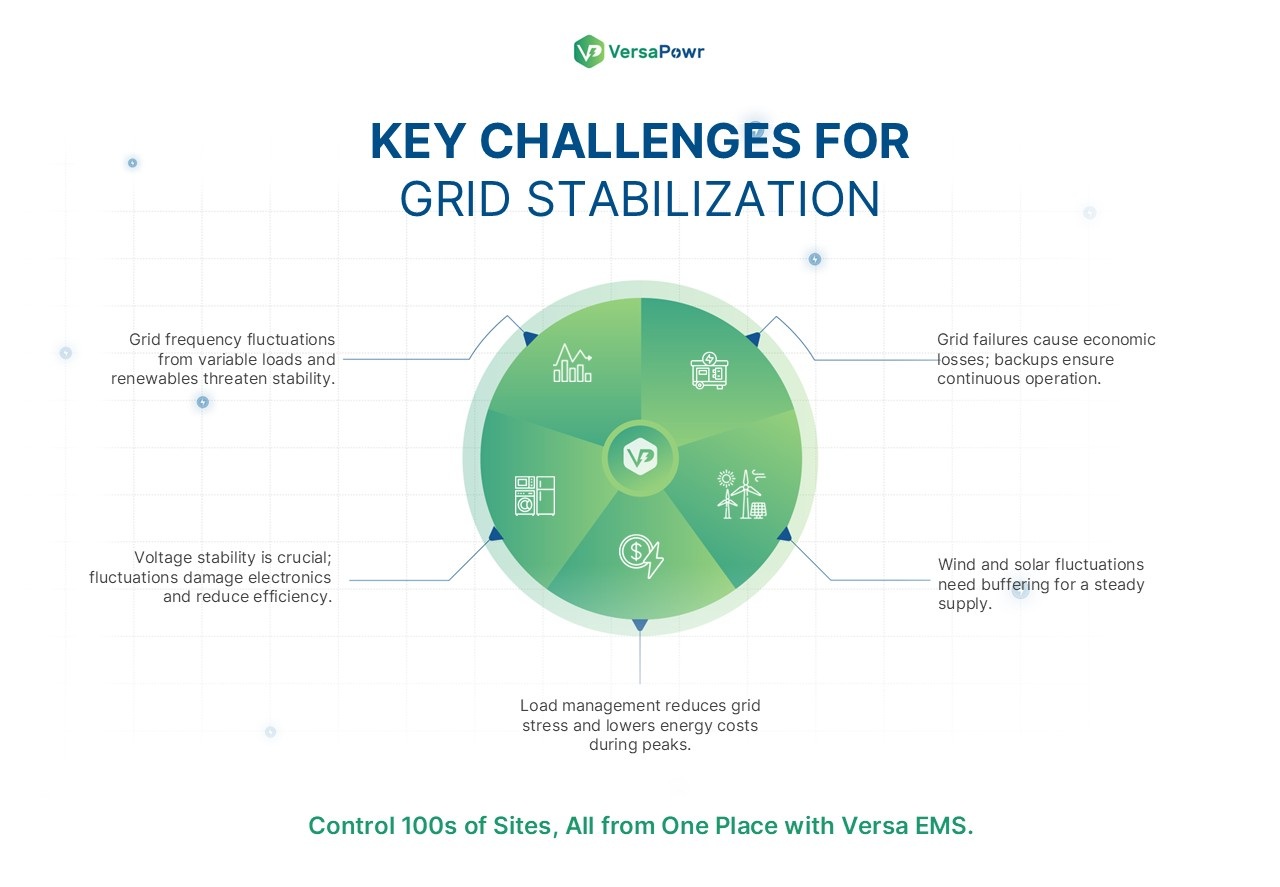How the Versa BESS 200 and Versa EMS provide the perfect solution for Grid Stabilization
The Versa BESS 200, a 100 kW/200 kWh Battery Energy Storage System, and Versa EMS offer advanced grid stabilization for commercial and industrial applications. By providing real-time frequency regulation, voltage support, and peak shaving, it ensures reliable energy supply, integrates renewable sources, and optimizes power usage.
- Published by: VersaPowr Press

In today’s rapidly evolving energy landscape, grid stabilization is a crucial aspect of ensuring reliability, and efficiency. With the growing integration of renewable energy sources, such as wind and solar, grid stability has become increasingly complex due to their inherent intermittency. Energy storage solutions play a pivotal role in balancing supply and demand, mitigating fluctuations, and enhancing the resilience of electrical networks.
The Versa BESS 200, a 100 kW/200 kWh Battery Energy Storage System (BESS) and Versa Energy Management System (EMS) offer a state-of-the-art solution tailored for commercial and industrial applications. Designed for flexibility, scalability, and reliability, the system seamlessly integrates into existing power networks, supporting multiple grid stabilization functions.
This article explores how Versa BESS 200 and EMS contribute to grid stabilization, its unique features, and its advantages for commercial and industrial users.

What is Grid Stabilization?
Grid stabilization is essential for maintaining a reliable and resilient power grid, especially as renewable energy sources like solar and wind become more prevalent. Since these sources are intermittent, ESS plays a crucial role in balancing supply and demand by storing excess energy when generation is high and releasing it when demand spikes or generation drops. This capability helps smooth out fluctuations, ensuring a steady and predictable power supply.
One of the key functions of ESS in grid stabilization is frequency regulation, where batteries or other storage technologies rapidly respond to deviations in grid frequency by injecting or absorbing power, keeping the system within safe operational limits. Similarly, ESS provides voltage support, helping to stabilize voltage fluctuations that can occur due to sudden changes in load or generation. Another critical function is peak shaving, where ESS reduces stress on the grid by storing electricity during periods of low demand and discharging it during peak times, improving overall grid efficiency and reducing the need for expensive infrastructure upgrades.

- Frequency Regulation:
The grid frequency must remain within a specific range to ensure stable power supply. Rapid fluctuations caused by varying loads and renewable energy output can destabilize the grid. - Voltage Regulation:
Consistent voltage levels are essential for the efficient operation of electrical equipment. Voltage fluctuations can damage sensitive electronics and reduce energy efficiency. - Peak Shaving and Load Shifting:
Managing high-demand periods and shifting loads to off-peak hours help alleviate grid stress and reduce energy costs. - Backup Power Supply:
Grid failures and blackouts can cause significant economic losses. A reliable backup system ensures continued operation.
- Integration of Renewable Energy Sources:
The fluctuating nature of wind and solar power requires buffering mechanisms to ensure a steady energy supply.

The Versa BESS 200 and Versa EMS is engineered to address these challenges, offering a robust and intelligent storage solution that enhances grid stability:
- Real-Time Frequency and Voltage Regulation
The Versa BESS 200 provides real-time dynamic power management, offering frequency regulation and voltage stabilization. By quickly absorbing or injecting power into the grid, it mitigates fluctuations, ensuring reliable grid performance and preventing system instability, crucial for avoiding blackouts and protecting infrastructure.
- Peak Shaving and Load Shifting Optimization
During peak demand, the Versa BESS 200 efficiently stores excess energy during low-demand periods and discharges during high-demand times, providing peak shaving. Additionally, it enables load shifting, reducing reliance on expensive grid energy during peak hours and ensuring more stable grid operation.
- High-Availability Backup Power
In the event of grid disruptions, the Versa BESS 200 offers backup power, ensuring energy resilience. Its rapid transition to stored energy ensures continued operation, minimizing downtime.
- Enabling Seamless Renewable Integration
The Versa BESS 200 effectively stores surplus energy generated from intermittent sources like wind and solar. This stored energy can be dispatched when renewable generation is low, enhancing grid stability and maximizing renewable energy utilization while reducing fossil fuel dependency.
- Scalable and Modular Deployment
The Versa BESS 200 is designed for scalability, supporting parallel installations for increasing storage capacity as energy demands rise. Its modular architecture makes it adaptable to a wide range of grid configurations, from microgrids to large-scale utilities, offering tailored solutions for grid stabilization. The Versa EMS manages the BESS cabinets as one combined resource, optimizing the utilization of each BESS.

Key Features of Versa BESS 200 and Versa EMS:
- Advanced Energy Management System (EMS)
The Versa BESS 200 integrates a high-performance EMS that optimizes power flow and enables real-time frequency regulation, peak shaving, voltage support, and load balancing. It uses advanced algorithms for rapid response to grid fluctuations and provides predictive analytics for efficient system operation.
- Three-Level Battery Management System (BMS)
The multi-level BMS ensures safe and balanced operation by continuously monitoring individual cells, modules, and the entire system. It optimizes charge/discharge cycles, prevents overheating, and performs health diagnostics to extend system life and ensure reliability.
- Thermal and Safety Management
The Versa BESS 200 features advanced thermal management with built-in air cooling and heating. Multi-layered protections, including heat, smoke, water, and gas detection, and an aerosol-based fire suppression system, prevent system failures and ensure safe operation in diverse environments.
- Grid Connectivity and Integration
Designed for seamless integration to 3rd party systems, the Versa EMS supports a wide range of communication protocols. It integrates with renewable sources such as solar and wind and supports virtual power plants (VPPs) for grid services.
- Scalable, Modular Architecture
The modular design allows for scalable deployments, from microgrids to large utility projects. Storage cabinets can be added or removed based on demand, optimizing cost-effectiveness and ensuring adaptability for diverse grid stabilization needs.
- High-Performance Power Conversion System (PCS)
The Versa BESS 200 is equipped with a high-efficiency power conversion system (PCS) that ensures seamless conversion between DC and AC with minimal loss. It supports high-speed power ramping and precise voltage regulation, optimizing the energy flow between the battery system and the grid.
Conclusion:
In conclusion, the Versa BESS 200 and Versa EMS stand out as a pivotal solution for addressing the complex challenges of modern power grids. As the world shifts toward renewable energy, the demand for reliable and stable electricity is growing, making grid stabilization a top priority. The Versa BESS 200, with its advanced features and capabilities, is designed to meet these challenges. Its ability to provide fast frequency regulation, voltage stabilization, and peak shaving ensures that the grid remains balanced even during periods of fluctuating energy generation and varying demand.
One of the standout advantages of the Versa BESS 200 and Versa EMS system is its role in integrating renewable energy sources like solar and wind, which are often intermittent in nature. By storing excess energy during times of high generation and releasing it when renewable output drops, the Versa BESS 200/EMS helps maintain a continuous, reliable energy supply, facilitating the transition to a cleaner, more sustainable grid.
Additionally, its black start capability and grid congestion management makes it a valuable asset for utilities, allowing for rapid power recovery after a failure and reducing the strain on existing transmission infrastructure. With its scalability and modular design, the Versa BESS 200 can be tailored to suit a wide range of grid stabilization needs, from small microgrids to large-scale utility applications.
The Versa BESS 200 and Versa EMS is more than just an energy storage system—it is a comprehensive solution that enhances grid resilience, optimizes energy usage, and supports the ongoing shift toward a greener, more reliable energy future.

